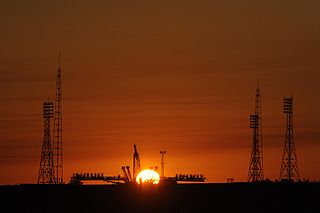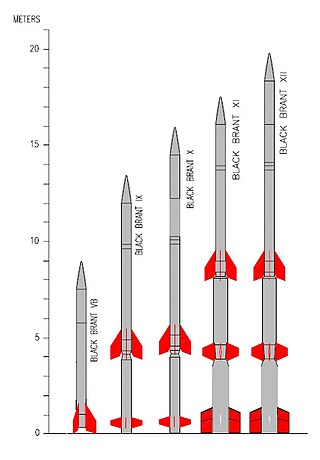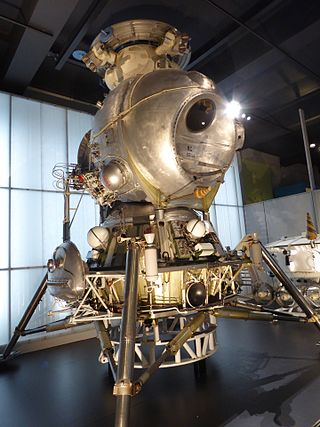Related Research Articles

Soyuz is a family of Soviet and later Russian expendable medium-lift launch vehicles developed by the OKB-1 design bureau and manufactured by the Progress Rocket Space Centre in Samara, Russia. It holds the record for the most launches in the history of spaceflight. Soyuz rockets are part of the R-7 rocket family, which evolved from the R-7 Semyorka, an intercontinental ballistic missile.

A spaceport or cosmodrome is a site for launching or receiving spacecraft, by analogy to a seaport for ships or an airport for aircraft. The word spaceport, and even more so cosmodrome, has traditionally been used for sites capable of launching spacecraft into orbit around Earth or on interplanetary trajectories. However, rocket launch sites for purely sub-orbital flights are sometimes called spaceports, as in recent years new and proposed sites for suborbital human flights have been frequently referred to or named "spaceports". Space stations and proposed future bases on the Moon are sometimes called spaceports, in particular if intended as a base for further journeys.

Vostok was a family of rockets derived from the Soviet R-7 Semyorka ICBM and was designed for the human spaceflight programme. This family of rockets launched the first artificial satellite and the first crewed spacecraft (Vostok) in human history. It was a subset of the R-7 family of rockets.

The Black Brant is a family of Canadian-designed sounding rockets originally built by Bristol Aerospace, since absorbed by Magellan Aerospace in Winnipeg, Manitoba. Over 800 Black Brants of various versions have been launched since they were first produced in 1961, and the type remains one of the most popular sounding rockets. They have been repeatedly used by the Canadian Space Agency and NASA.

The N1/L3 was a super heavy-lift launch vehicle intended to deliver payloads beyond low Earth orbit. The N1 was the Soviet counterpart to the US Saturn V and was intended to enable crewed travel to the Moon and beyond, with studies beginning as early as 1959. Its first stage, Block A, was the most powerful rocket stage ever flown for over 50 years, with the record standing until Starship's first integrated flight test. However, each of the four attempts to launch an N1 failed in flight, with the second attempt resulting in the vehicle crashing back onto its launch pad shortly after liftoff. Adverse characteristics of the large cluster of thirty engines and its complex fuel and oxidizer feeder systems were not revealed earlier in development because static test firings had not been conducted.

Soyuz-U was a Soviet and later Russian expendable medium-lift launch vehicle designed by the TsSKB design bureau and constructed at the Progress factory in Samara, Russia. The U designation stands for unified, as the launch vehicle was the replacement for both the Voskhod rocket and the original Soyuz rocket. The Soyuz-U is part of the R-7 rocket family, which evolved from the R-7 Semyorka, an intercontinental ballistic missile.
Deep Space Expedition Alpha (DSE-Alpha), is the name given to the mission proposed in 2005 to take the first space tourists to fly around the Moon. The mission is organized by Space Adventures Ltd., a commercial spaceflight company. The plans involve a modified Soyuz capsule docking with a booster rocket in Earth orbit which then sends the spacecraft on a free return circumlunar trajectory that circles around the Moon once. While the price was originally announced in August 2005 to cost US$100 million per seat, Space Adventures founder Eric Anderson announced in January 2011 that one of the two available seats had been sold for $150 million.

The RD-170 is the world's most powerful and heaviest liquid-fuel rocket engine. It was designed and produced in the Soviet Union by NPO Energomash for use with the Energia launch vehicle. The engine burns kerosene fuel and LOX oxidizer in four combustion chambers, all supplied by one single-shaft, single-turbine turbopump rated at 170 MW (230,000 hp) in a staged combustion cycle.
Kosmos 670 was an unmanned Soyuz 7K-S test. It used a new and unique inclination of 50.6 degree. The experience from these flights were used in the development of the successor program Soyuz spacecraft the Soyuz 7K-ST.
Kosmos 772 was an uncrewed military Soyuz 7K-S test. It was an unsuccessful mission as only one transmitter worked. Only the 166 MHz frequency transmitter operated, all of the other normal Soyuz wavelengths transmitters failed. The experience from these flights were used in the development of the successor program Soyuz spacecraft the Soyuz 7K-ST.

NPO Energomash "V. P. Glushko" is a major Russian rocket engine manufacturer. The company primarily develops and produces liquid propellant rocket engines. Energomash originates from the Soviet design bureau OKB-456, which was founded in 1946. NPO Energomash acquired its current name on May 15, 1991, in honor of its former chief designer Valentin Glushko.
The Universal Rocket or UR family of missiles and carrier rockets is a Russian, previously Soviet rocket family. Intended to allow the same technology to be used in all Soviet rockets, the UR is produced by the Khrunichev State Research and Production Space Center. Several variants were originally planned, of which only three flew, and only two of which entered service. In addition, the cancelled UR-500 ICBM formed the basis for the Proton carrier rocket.

Soyuz TMA-19 was a crewed spaceflight to the International Space Station (ISS) and is part of the Soyuz programme. It was launched on 15 June 2010 carrying three members of the Expedition 24 crew to the International Space Station, who remained aboard the station for around six months. Soyuz TMA-19 was the 106th crewed flight of a Soyuz spacecraft, since the first mission which was launched in 1967. The spacecraft remained docked to the space station for the remainder of Expedition 24, and for Expedition 25, to serve as an emergency escape vehicle. It undocked from ISS and landed in Kazakhstan on 26 November 2010. It was the 100th mission to be conducted as part of the International Space Station programme since assembly began in 1998.
The Zarya spacecraft was a secret Soviet project of the late 1980s aiming to design and build a large crewed vertical-takeoff, vertical-landing (VTVL) reusable space capsule, a much larger replacement for the Soyuz (spacecraft). The project was developed during the years of 1985–1989 by Energia corporation until it was shelved in 1989, "on the eve of the Soviet Union's collapse" due to lack of funding. The name of the project was later reused by the Zarya space station module which served as the first component of International Space Station in 1998.
The Star is a family of US solid-propellant rocket motors originally developed by Thiokol and used by many space propulsion and launch vehicle stages. They are used almost exclusively as an upper stage, often as an apogee kick motor. The number designations refer to the approximate diameter of the fuel casing in inches.
Volga is a Russian rocket upper stage designed for use with the Soyuz 2.1a and Soyuz 2.1v rockets. It was derived from the propulsion module of the Yantar satellite, and is closely related to the retired Ikar upper stage. It serves as a lighter and more cost-effective alternative to the Fregat upper stage, used on most many Soyuz 2 missions. Progress began development of the Volga in 2008 and the design was finalized in 2010.

In the event of catastrophic failure, the Soyuz spacecraft has a series of automated and semi-automated abort modes to rescue the crew. The abort systems have been refined since the first piloted flights and all abort scenarios for the Soyuz MS are expected to be survivable for the crew.

Soyuz Kontakt(Soyuz Contact) was the docking hardware of the Soviet crewed lunar spacecraft program. The Soviet lunar human program was canceled in 1974 after many failures. Four failures of the N-1 Rocket super heavy-lift launch vehicle and the success of the U.S. Apollo program ended the Soviet crewed moon program.
References
- ↑ "IKAR Upper Stage". TsSKB-Progress. Retrieved 21 December 2015.
- ↑ "Блок выведения 'Икар'" [Spacetug 'Ikar']. www.cosmopark.ru (in Russian). Retrieved 2016-11-04.
- ↑ "Soyuz 11A511U / Ikar". Astronautix.com. Archived from the original on 2012-10-05. Retrieved 2012-09-04.
- ↑ "17D61". Astronautix.com. Archived from the original on 2012-10-04. Retrieved 2012-09-04.